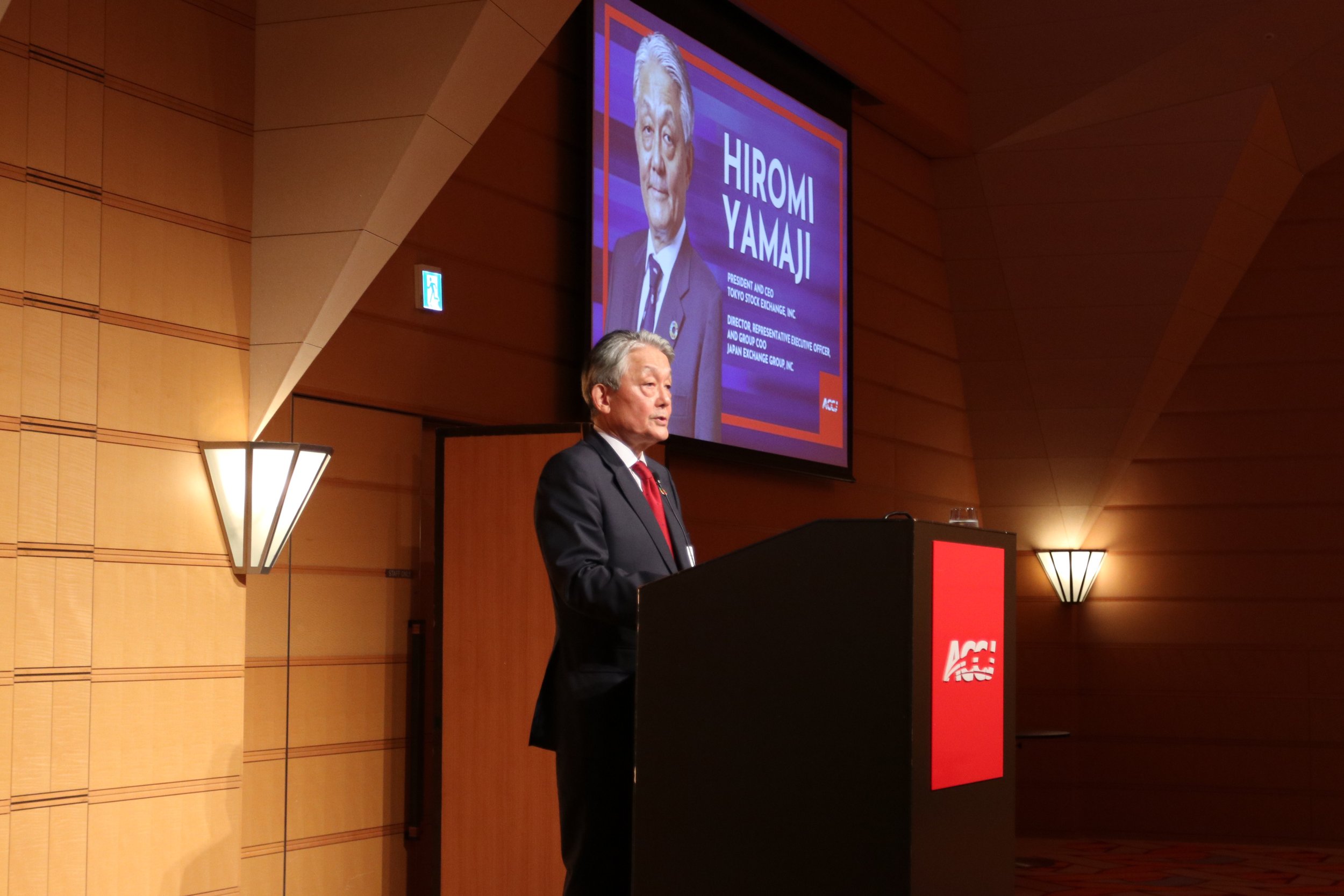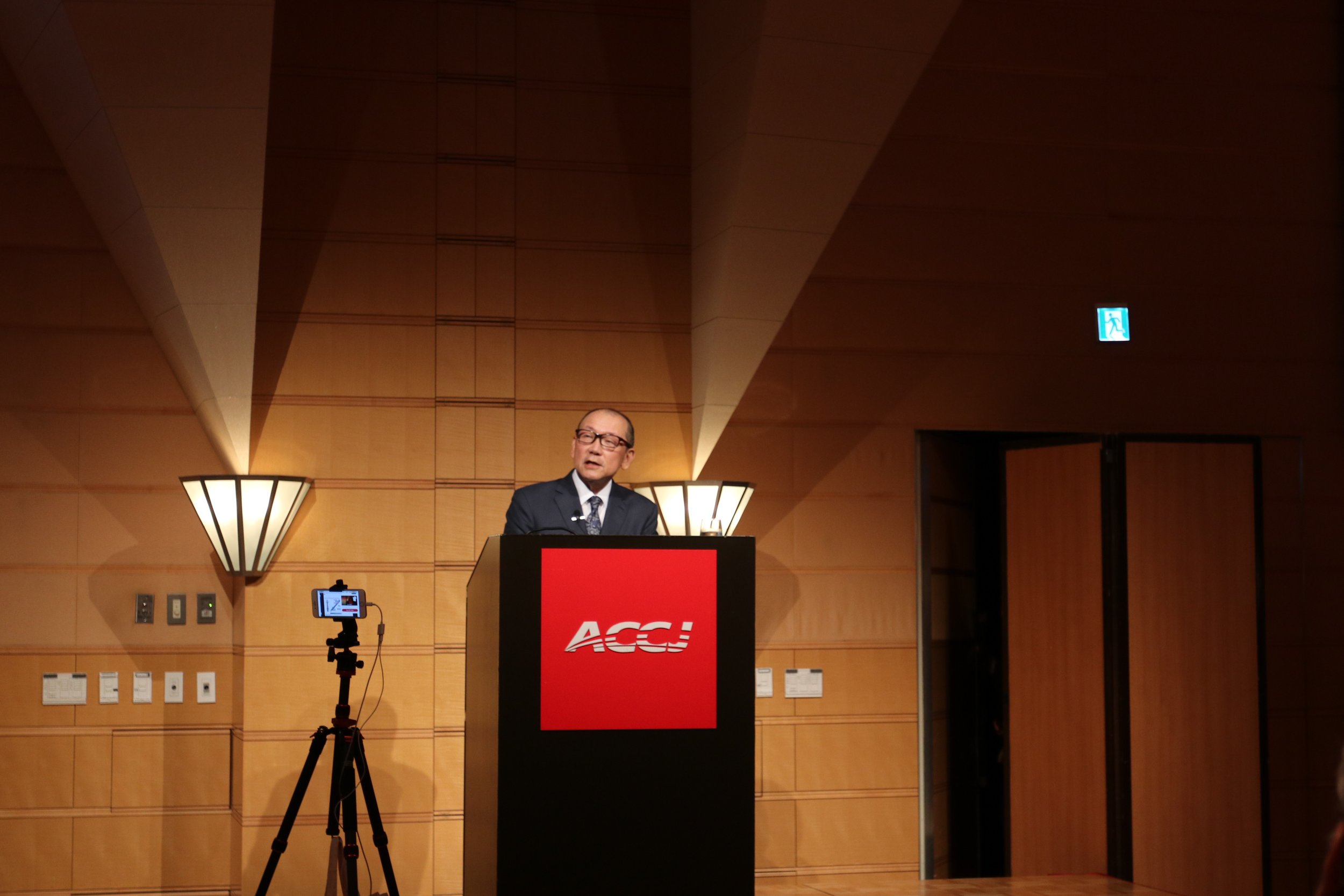Activist Investing in 2022
Fourth Annual ACCJ Shareholder Forum brings together experts from Japan and overseas for a look at the state of the market
Tokyo Stock Exchange President and CEO Hiromi Yamaji delivers the keynote.
Why should anyone care about activist investing in Japan?
This is the question posed by American Chamber of Commerce in Japan (ACCJ) Alternative Investment Committee Chair Frank Packard as he opened the Fourth Annual ACCJ Shareholder Forum on June 7 at Tokyo American Club. The event, which was also livestreamed to remote attendees, has become an important part of the annual general meeting (AGM) season.
Four speakers explored this through a wide-ranging look at the realities of the Japanese market, corporate governance, activist investing, stewardship, shareholder proposals, and more after the keynote was delivered by Hiromi Yamaji, president and chief executive officer of Tokyo Stock Exchange, Inc. (TSE) as well as director, representative officer, and group chief operating officer of Japan Exchange Group, Inc.
Presenting were:
- Nicholas Smith, strategist with CLSA
- Andrew McDermott, president of Mission Value Partners
- Tsuyoshi Maruki, president and CEO of Strategic Capital
- Seth Fischer, founder and chief investment officer at Oasis Management
Packard himself offered some thoughts during the introduction.
“The past 30 years in Japanese public equities provide an interesting lens for today,” he explained. “I want to make the case that we should pay attention because active engagement in Japan might actually be the best global investment strategy today.”
This was not always the case. After the bubble economy of the 1980s burst, activist investing in Japan during the 1990s was somewhat primitive, Packard said. “Some notorious examples, often American, featured activists making simple demands for immediate action to get quick financial return for themselves, not for the companies or other shareholders. To be clear, activism in Japan did not start with an attractive image. But it’s come a long way.”
Japan’s Financial Services Agency began providing useful frameworks with written regulations in 2014 to encourage corporate governance and investor stewardship. Today, Japan is the world’s second-biggest market for activism. “Activists are doing well by doing good,” he said. These days, you’ll find many other groups addressing important governance topics—diversity of board members, foreigners as directors, and talk about disclosure on environmental, social, and corporate governance topics.”
But, Packard noted, very few people are focusing on the other code—the stewardship code—and what are best practices for improving corporate value. “This absence, we believe, is an opportunity for the ACCJ.”
Is ESG Good?
One of the most frequently heard terms in discussions of investing these days is ESG. And while a focus on improving environmental, social, and corporate governance would appear to be good, there are some growing doubts about how to apply it in a decision-useful and commercial manner.
“In theory, [addressing] climate change is a noble goal. Increasing disclosure of environmental impact, as the TSE has recommended and the ACCJ has advocated, that’s very good, too. But in practice, investing in ESG assets has led to many cases of greenwashing,” Packard said, using the term that refers to making inflated, unsubstantiated, or even false claims about the environmentally friendly nature of a product or practice.
“We’re seeing a lack of agreement on ratings and benchmarks, and some concerns that ESG might actually be too blunt an instrument for financial services,” he explained. “Some of the leaders of financial firms are now saying that, maybe, it’s time to retire ESG and its application for investing.”
Lastly, Packard asked where activist investing fits into today’s financial markets, at a time when all asset classes fell in value for the first time in 30 years. That happened during the first quarter of this year. “This has been very confusing for investors trying to do the right thing. Where can investors go to embrace sustainability and responsible investments? Could the answer be to focus on active investment and active engagement?” he asked. “It’s not only an academic or ethical question, it might also be optimal strategy in the current financial markets.”
A Look at the Market
Next, Yamaji delivered the keynote and spoke about what he sees as very important changes in the Japanese market.
“In addition to the excitement generated by the lifting of Covid-19 restrictions, this also has been an exciting time for us at the TSE as [we] went through a major overhaul this past April, kicking off major changes in the Japanese capital market.”
The TSE revamped its grouping of shares for the first time since 1961, replacing its four-market structure with one comprising three: prime, standard, and growth. The top tier is home to blue chips that have met corporate governance requirements which are higher than those of the previous first section. More than 80 percent of the companies that were listed in the first section have shifted to the prime market.
“As shareholders and investors engage with these companies, Japanese companies are undertaking significant changes to their business growth strategies through realignment of their business portfolio and through their new approaches to corporate governance,” Yamaji added.
The presentation portion of the event covered:
- A vertical review of activism comparison over several years as well as a horizontal view of the different engagements within the AGM season, provided by CLSA’s Smith
- A look at stewardship, what it means, and how it applies to 2022 Japan, as well as additional thoughts on ESG, from Mission Value Partners’ McDermott, who joined online from Tennessee
- A fund manager’s perspective on activism and tools used for preparing shareholder proposals, offered by Strategic Capital’s Maruki
- A recap of some past shareholder proposals and a look at the power of engagement and the 2022 proxy season, presented by Oasis’s Fischer
Packard concluded the event by thanking everyone who made it possible, including the ACCJ programs and communications teams as well as his fellow Alternative Investment Committee leaders, Vice-Chairs Pieter Franken, Deborah Hayden, Jason Topaz, and Christopher Wells. It was a great cooperative success.
Watch The ACCJ Journal for additional extended coverage of the presentations, coming soon.













